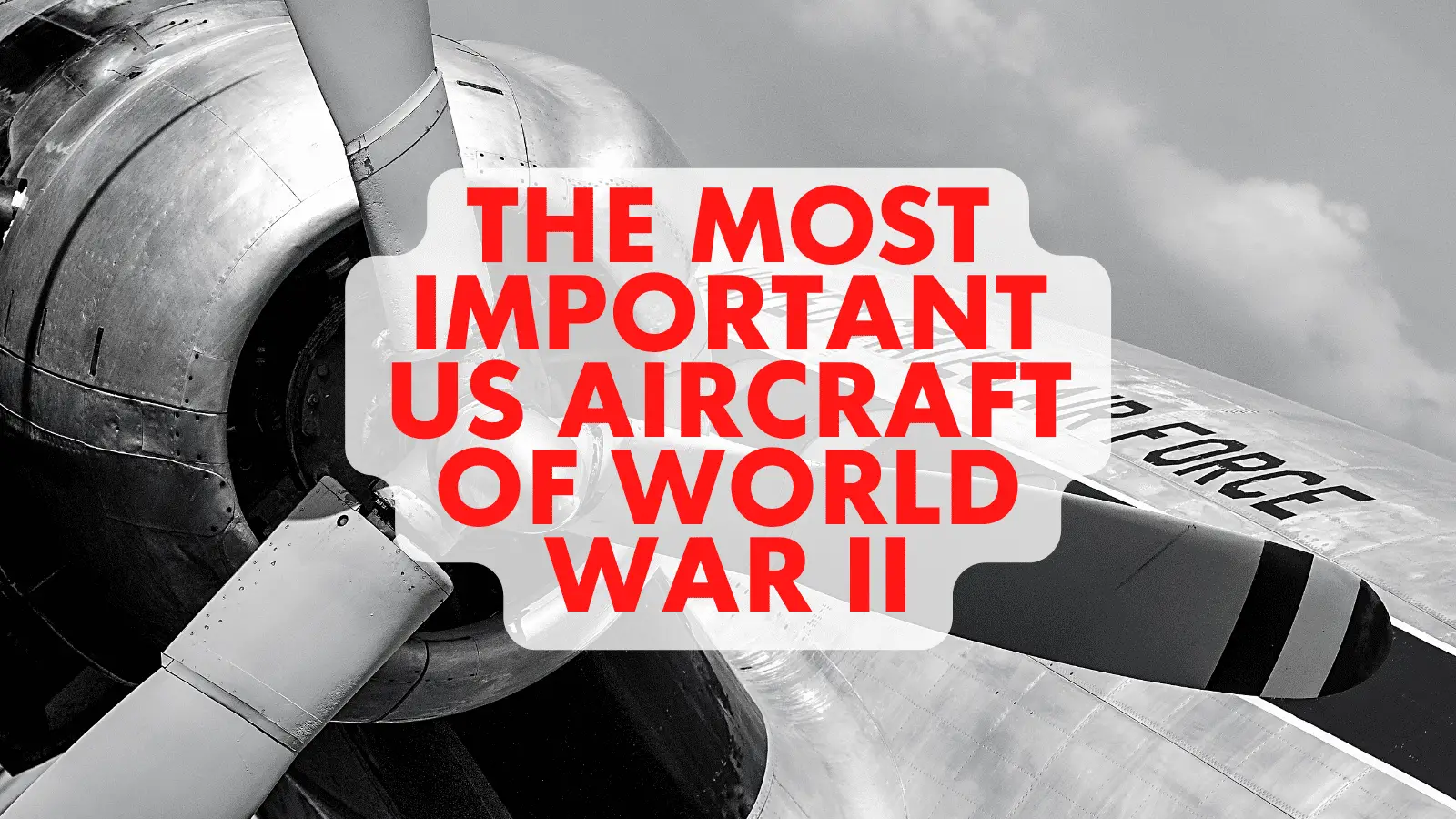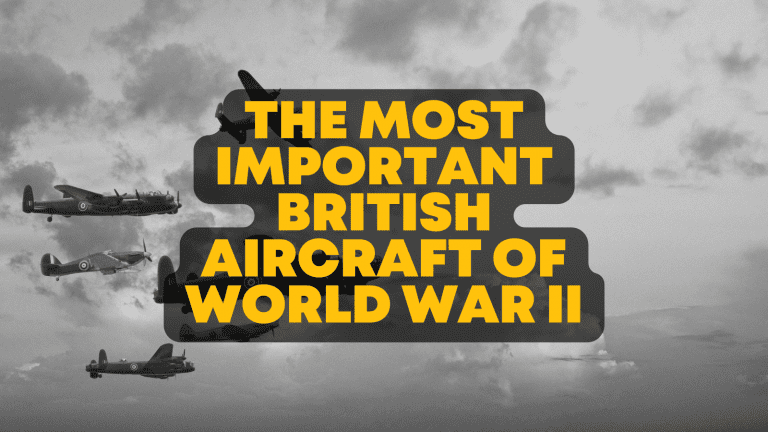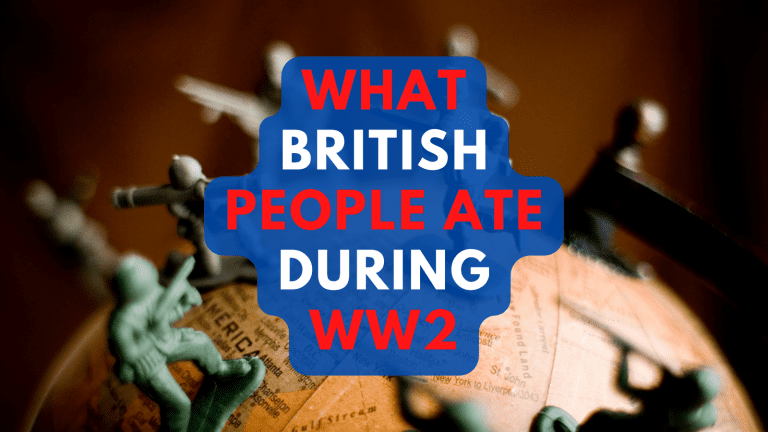The Most Important US Aircraft of World War II
Unlike many European nations, the United States entered WWII significantly later. Their official declaration of war did not occur until after the bombing of Pearl Harbor in 1941. As a result of this delayed entry, the United States had more time than countries like France and Britain to prepare. They did this by ramping up production, co-opting civilian factories, and researching innovative new designs. Due to the distance to the western front and the oceanic nature of the Pacific theatre, aircraft were of particular importance. Unlike among European countries, sea and land units would not be able to cross the distances from the homeland to the front in a timely manner without the support of an advanced air force.
[/et_pb_text][/et_pb_column][/et_pb_row][et_pb_row _builder_version=”4.14.8″ _module_preset=”default” global_colors_info=”{}”][et_pb_column type=”4_4″ _builder_version=”4.14.8″ _module_preset=”default” global_colors_info=”{}”][et_pb_text _builder_version=”4.14.8″ _module_preset=”default” global_colors_info=”{}”]Douglas DC-3 Dakota
[/et_pb_text][/et_pb_column][/et_pb_row][et_pb_row _builder_version=”4.14.8″ _module_preset=”default” column_structure=”1_5,3_5,1_5″][et_pb_column _builder_version=”4.14.8″ _module_preset=”default” type=”1_5″][/et_pb_column][et_pb_column _builder_version=”4.14.8″ _module_preset=”default” type=”3_5″][et_pb_image src=”http://historywithhenry.com/wp-content/uploads/2022/03/1.png” _builder_version=”4.14.8″ _module_preset=”default” alt=”The Most Important US Aircraft of World War II” title_text=”1″ hover_enabled=”0″ sticky_enabled=”0″][/et_pb_image][/et_pb_column][et_pb_column _builder_version=”4.14.8″ _module_preset=”default” type=”1_5″][/et_pb_column][/et_pb_row][et_pb_row _builder_version=”4.14.8″ _module_preset=”default” global_colors_info=”{}”][et_pb_column type=”4_4″ _builder_version=”4.14.8″ _module_preset=”default” global_colors_info=”{}”][et_pb_text _builder_version=”4.14.8″ _module_preset=”default” global_colors_info=”{}”]Essential in solving the logistical problems of the United States was the DC-3 Dakota. The DC-3 Dakota was an Airliner, and Transport Aircraft produced between 1936 and 1950. Its manufacturer, the USA-based Douglas Aircraft Company, produced 607 planes of this design for civilian use. The DC-3 was faster, could fly longer, and was more reliable than its predecessors. In addition, it carried passengers in greater comfort. Originally working as a civilian aircraft before the war, it could cross the continental US in 18 hours. It was the first passenger aircraft to turn a profit without mail-carrying subsidies. Many of the DC-3 Dakota airliners were drafted for the war effort during the war. An estimated 10,000 additional military versions of the aircraft were built under the designations C-47, C-53, R4D, and Dakota. They were used to transport troops, supplies, and wounded. After the war, ex-military planes flooded the civilian market, reducing the dominance of the DC-3 Dakota.
[/et_pb_text][/et_pb_column][/et_pb_row][et_pb_row _builder_version=”4.14.8″ _module_preset=”default” global_colors_info=”{}”][et_pb_column type=”4_4″ _builder_version=”4.14.8″ _module_preset=”default” global_colors_info=”{}”][et_pb_text _builder_version=”4.14.8″ _module_preset=”default” global_colors_info=”{}”]Grumman F6F Hellcat
[/et_pb_text][/et_pb_column][/et_pb_row][et_pb_row _builder_version=”4.14.8″ _module_preset=”default” global_colors_info=”{}”][et_pb_column type=”4_4″ _builder_version=”4.14.8″ _module_preset=”default” global_colors_info=”{}”][et_pb_text _builder_version=”4.14.8″ _module_preset=”default” global_colors_info=”{}”]The Grumman F6F Hellcat was designed as a carrier-based aircraft during WWII. It was initially flown and produced in 1942 and was fully introduced to military service by the end of 1943. The last active-duty F6F Hellcats were retired in 1960. During this period of service, 12,275 Hellcats were manufactured. The Hellcat was a rugged fighter and was integral in achieving air superiority in the Pacific Theatre. The main innovation between the Hellcat and previous models was the hydraulically powered landing gear and the folding wings, making it very space-efficient to transport on aircraft carriers.
[/et_pb_text][/et_pb_column][/et_pb_row][et_pb_row _builder_version=”4.14.8″ _module_preset=”default” global_colors_info=”{}”][et_pb_column type=”4_4″ _builder_version=”4.14.8″ _module_preset=”default” global_colors_info=”{}”][et_pb_text _builder_version=”4.14.8″ _module_preset=”default” global_colors_info=”{}”]Republic P-47 Thunderbolt
[/et_pb_text][/et_pb_column][/et_pb_row][et_pb_row _builder_version=”4.14.8″ _module_preset=”default” global_colors_info=”{}”][et_pb_column type=”4_4″ _builder_version=”4.14.8″ _module_preset=”default” global_colors_info=”{}”][et_pb_text _builder_version=”4.14.8″ _module_preset=”default” global_colors_info=”{}”]The Republic P-47 Thunderbolt was one of the heaviest fighters of WWII. It could carry a bomb load of over 1000 kg of bombs and 5-inch rockets when fully loaded. It was introduced in 1942 and was most effective as a medium-range escort fighter. The P-47 constituted the majority of the US Air Forces’ fighters during WWII and saw service in other allied armies. Pilots knew it as “The Jug” due to the roomy bubble cockpit, which made a similar shape to a milk jug. Initial missions with the P-47 thunderbolt were failures due to faulty radios and poorly assembled engines. These were replaced with new parts, given lots of tune-ups, and their deployment into air combat over France went smoothly after that. Much of their use was in French airspace fighting the Luftwaffe. In the course of its active use, 15,636 P-47s were built.
[/et_pb_text][/et_pb_column][/et_pb_row][et_pb_row _builder_version=”4.14.8″ _module_preset=”default” global_colors_info=”{}”][et_pb_column type=”4_4″ _builder_version=”4.14.8″ _module_preset=”default” global_colors_info=”{}”][et_pb_text _builder_version=”4.14.8″ _module_preset=”default” global_colors_info=”{}”]Lockheed P-38 Lightning
[/et_pb_text][/et_pb_column][/et_pb_row][et_pb_row _builder_version=”4.14.8″ _module_preset=”default” global_colors_info=”{}”][et_pb_column type=”4_4″ _builder_version=”4.14.8″ _module_preset=”default” global_colors_info=”{}”][et_pb_text _builder_version=”4.14.8″ _module_preset=”default” global_colors_info=”{}”]The Lockheed P-38 Lightning was the first US plane to take advantage of Stainless Steel and flush riveted Aluminium sheeting. It was sleekly put together for record speeds of over 640 km/h (400 mph) in level flight. It was designed using the word “interceptor” due to limitations in pursuit aircraft specifications. This turn of phrase gave them license to make a two-engine single-pilot fighter, as well as a higher amount of armament. The P-38 Lightning contained a minimum of 450 Kg (1000 lbs.) of armament. Unlike most fighters, it had nose-mounted guns. This allowed for greater effective range and a higher skill cap for talented pilots. Production of the P-38 only reached 30 units before news from UK pilots resulted in design changes in 1940. However, the Lightning series remained in constant production throughout WWII, and over 10,000 were manufactured. Throughout WWII, the Lockheed Lightning was a dominant dogfighter, especially in the Pacific Theatre.
[/et_pb_text][/et_pb_column][/et_pb_row][et_pb_row _builder_version=”4.14.8″ _module_preset=”default” global_colors_info=”{}”][et_pb_column type=”4_4″ _builder_version=”4.14.8″ _module_preset=”default” global_colors_info=”{}”][et_pb_text _builder_version=”4.14.8″ _module_preset=”default” global_colors_info=”{}”]North American P-51 Mustang
[/et_pb_text][/et_pb_column][/et_pb_row][et_pb_row _builder_version=”4.14.8″ _module_preset=”default” global_colors_info=”{}”][et_pb_column type=”4_4″ _builder_version=”4.14.8″ _module_preset=”default” global_colors_info=”{}”][et_pb_text _builder_version=”4.14.8″ _module_preset=”default” global_colors_info=”{}”]The North American P-51 Mustang was a long-range fighter-bomber produced by the United States between 1940 and 1953. It was originally designed as a self-protecting bomber. Still, doubts from the United States Airforce on the viability of a self escorting bomber saw North Americans tweak their design into a more escort-focused plane. It could fly at 4,600 m (15,000 ft.) without sacrificing any of its substantial range. Approximately 15,000 of the P-51 Mustang were produced. Despite this success, the P-51 sustained heavy losses in Strafing missions due to its liquid cooling tanks – which were vulnerable to ground fire. Its primary usage was as a general use bomber for day and night missions during WWII.
[/et_pb_text][/et_pb_column][/et_pb_row][et_pb_row _builder_version=”4.14.8″ _module_preset=”default” global_colors_info=”{}”][et_pb_column type=”4_4″ _builder_version=”4.14.8″ _module_preset=”default” global_colors_info=”{}”][et_pb_text _builder_version=”4.14.8″ _module_preset=”default” global_colors_info=”{}”]Consolidated PBY Catalina
[/et_pb_text][/et_pb_column][/et_pb_row][et_pb_row _builder_version=”4.14.8″ _module_preset=”default” global_colors_info=”{}”][et_pb_column type=”4_4″ _builder_version=”4.14.8″ _module_preset=”default” global_colors_info=”{}”][et_pb_text _builder_version=”4.14.8″ _module_preset=”default” global_colors_info=”{}”]The Consolidated PBY Catalina was an amphibious aircraft. It was a very widely used seaplane in WWII, seeing deployment by the US, UK, Canada, and the Soviet Union. The Catalina was slow and not very agile, but they were used for various roles they were never attended to. It functioned as a Maritime Patrol Plane, an anti-submarine unit, and a search and rescue seaplane during the war. For instance, the Catalina rescued hundreds of airmen downed over water. Equally impactful were missions against German U boats. Approximately 40 German U-boats were sunk by Catalinas over the course of the war, despite the robust anti-aircraft defences that many U-boats were equipped with. In the modern-day, it is still used as a water bomber, although none remain in active military service. 3,308 of these aircraft were built.
[/et_pb_text][/et_pb_column][/et_pb_row][et_pb_row _builder_version=”4.14.8″ _module_preset=”default” global_colors_info=”{}”][et_pb_column type=”4_4″ _builder_version=”4.14.8″ _module_preset=”default” global_colors_info=”{}”][et_pb_text _builder_version=”4.14.8″ _module_preset=”default” global_colors_info=”{}”]Consolidated B-24 Liberator
[/et_pb_text][/et_pb_column][/et_pb_row][et_pb_row _builder_version=”4.14.8″ _module_preset=”default” column_structure=”1_5,3_5,1_5″][et_pb_column _builder_version=”4.14.8″ _module_preset=”default” type=”1_5″][/et_pb_column][et_pb_column _builder_version=”4.14.8″ _module_preset=”default” type=”3_5″][et_pb_image src=”http://historywithhenry.com/wp-content/uploads/2022/03/2.png” _builder_version=”4.14.8″ _module_preset=”default” alt=”The Most Important US Aircraft of World War II” title_text=”2″ hover_enabled=”0″ sticky_enabled=”0″][/et_pb_image][/et_pb_column][et_pb_column _builder_version=”4.14.8″ _module_preset=”default” type=”1_5″][/et_pb_column][/et_pb_row][et_pb_row _builder_version=”4.14.8″ _module_preset=”default” global_colors_info=”{}”][et_pb_column type=”4_4″ _builder_version=”4.14.8″ _module_preset=”default” global_colors_info=”{}”][et_pb_text _builder_version=”4.14.8″ _module_preset=”default” global_colors_info=”{}”]The Consolidated B-24 Liberator was a heavy bomber designed in San Diego, California. It served as an anti-submarine aircraft, as well as a maritime patrol aircraft. Active use of the B-24 Liberator went from 1941 to 1968. There were approximately 18,000 produced, and it was primarily used by the United States Air Force and the Royal Air Force. The Liberator had an efficient shoulder-mounted, high aspect ratio Davis wing, which gave it a high cruise speed, long-range, and large carrying capacity. General staff heavily favoured it for various missions, including long haul over water missions in the Pacific Theatre and the long-range raid on the oil industry at Ploesti, Romania in 1943. Its speed and fuel efficiency made it a great tactical choice. However, aircrews generally preferred the B-17 Flying Fortress due to the comparative difficulty of flying the B-24 Liberator and its poor handling at low speeds.
[/et_pb_text][/et_pb_column][/et_pb_row][et_pb_row _builder_version=”4.14.8″ _module_preset=”default” global_colors_info=”{}”][et_pb_column type=”4_4″ _builder_version=”4.14.8″ _module_preset=”default” global_colors_info=”{}”][et_pb_text _builder_version=”4.14.8″ _module_preset=”default” global_colors_info=”{}”]Boeing B-17 Flying Fortress
[/et_pb_text][/et_pb_column][/et_pb_row][et_pb_row _builder_version=”4.14.8″ _module_preset=”default” global_colors_info=”{}”][et_pb_column type=”4_4″ _builder_version=”4.14.8″ _module_preset=”default” global_colors_info=”{}”][et_pb_text _builder_version=”4.14.8″ _module_preset=”default” global_colors_info=”{}”]The Boeing B-17 Flying Fortress was the design based on one Boeing had submitted for a United States Army Air Corps contract to build 200 heavy bombers during the 1930s. However, the prototypes crashed, and the contract was given to another company. The USAAC was convinced of the ideas’ potential and ordered 13 more B-17s for further study. After several more refinements in the Flying Fortress’ design, it became one of the most highly produced bombers of all time. Their primary use during WWII was the daytime bombing of key German industrial, military, and civilian targets.
[/et_pb_text][/et_pb_column][/et_pb_row][et_pb_row _builder_version=”4.14.8″ _module_preset=”default” global_colors_info=”{}”][et_pb_column type=”4_4″ _builder_version=”4.14.8″ _module_preset=”default” global_colors_info=”{}”][et_pb_text _builder_version=”4.14.8″ _module_preset=”default” global_colors_info=”{}”]Boeing B-29 Super Fortress
[/et_pb_text][/et_pb_column][/et_pb_row][et_pb_row _builder_version=”4.14.8″ _module_preset=”default” column_structure=”1_5,3_5,1_5″][et_pb_column _builder_version=”4.14.8″ _module_preset=”default” type=”1_5″][/et_pb_column][et_pb_column _builder_version=”4.14.8″ _module_preset=”default” type=”3_5″][et_pb_image src=”http://historywithhenry.com/wp-content/uploads/2022/03/3.png” _builder_version=”4.14.8″ _module_preset=”default” alt=”The Most Important US Aircraft of World War II” title_text=”3″ hover_enabled=”0″ sticky_enabled=”0″][/et_pb_image][/et_pb_column][et_pb_column _builder_version=”4.14.8″ _module_preset=”default” type=”1_5″][/et_pb_column][/et_pb_row][et_pb_row _builder_version=”4.14.8″ _module_preset=”default” global_colors_info=”{}”][et_pb_column type=”4_4″ _builder_version=”4.14.8″ _module_preset=”default” global_colors_info=”{}”][et_pb_text _builder_version=”4.14.8″ _module_preset=”default” global_colors_info=”{}”]The B-29 Super Fortress was a large, four propellers heavy bomber manufactured during WWII by the United States. This plane ran many of the blanket bombing missions carried out against Japan after its first missions in 1941. As many as 1,000 B-29s would bomb Tokyo city at a time, and approximately 30 Japanese planes were shot down by B-29s. The Super Fortress was the ideological successor to the Flying Fortress, improving on its design with a higher payload threshold and capability for longer flights. The Boeing B-29 Super Fortress would be the plane that dropped the atomic bomb on both Nagasaki and Hiroshima, making it the only aircraft to date that has fired nuclear weapons. The first bomb dropped on August 5th, 1945, and the second followed three days later.
[/et_pb_text][/et_pb_column][/et_pb_row][/et_pb_section]





